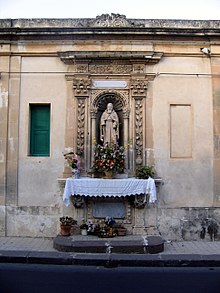敬奉

在诺托(Noto)对皮亚琴察的圣柯瑞 (San Corrado)的敬奉
在基督教中,“敬奉”(英语:veneration;拉丁語:veneratio;希臘語:δουλια,dulia)或veneration of saints,是一个纪念圣人的特别活动,后者在该宗教传统中被确认为非凡者。该活动在东正教会、罗马天主教会,有时也在圣公宗成员中举行。敬奉经常在表面上显示为在圣人的圣像画、圣髑或雕像前恭敬地鞠躬或画十字聖號(sign of the cross)。上述各项物品也可能被亲吻。
本词在中文中的翻译除“敬奉”外,还有“敬礼”、“恭敬”等译法。
目录
1 罗马天主教,正教,及圣公宗
2 其他宗教传统
3 参考文献
3.1 引用
3.2 来源
4 参见
罗马天主教,正教,及圣公宗
在罗马天主教、正教、及盎格鲁天主教(Anglo-Catholicism)神学中,敬奉是不同于仅属于上帝的崇拜(adoration)的一种尊敬。根据来自斯丢本维尔方济各会大学(Franciscan University of Steubenville)的执事(Deacon)马克·米拉维里博士(Dr. Mark Miravelle)的研究,英文单词"worship"与veneration和adoration都相关。[1]
教会神学家们长期使用拉丁文名词latria以指仅归上帝的崇拜类型,而用dulia指对圣人和圣像画(icons)的敬奉(veneration)。天主教神学也将专指天主教传统中对圣母玛利亚的敬礼类型的名词hyperdulia包括在敬奉中。此区别在第七届大公会议(Seventh Ecumenical Council)(787年)的教义(dogma)结论中便被阐明,该大公会议也颁布教令称圣像破坏主义(iconoclasm)(禁止圣像和其敬奉)是异端,等于否定了耶稣的道成肉身(incarnation)。
如今,罗马天主教传统通过专攻圣母玛利亚学的宗座学校如宗座玛利亚神学学院(Marianum),经由圣母玛利亚学(Mariology)领域很好地建立了关于敬奉童贞玛利亚的哲学。[2][3][4].
在希伯来语中,尊敬一个人如国王或先知的词汇是שׁחה,这与崇拜上帝的词是一个词。[5]此种崇拜或对人的尊敬的例子可见1 Kings 1:23 ,其中先知納堂(Nathan)对達味王(King David)鞠躬 (שָׁחָה)(以下为英文原文):
And they told the king saying, "Behold, Nathan the prophet." And he came in before the king and he prostrated himself unto the king upon his face, to the ground.
该词亦可见于Genesis 23:7, 27:29, 33:3, 2 Kings 2:15, 1 Samuel 25:41以指通过向其鞠躬或拜倒以表示的对人的尊敬。
对一位天使——在拉比的评注中被确定为总领天使弥额尔(Archangel Michael)——的敬奉[6]可见于Joshua 5:14(以下为英文原文):
And he said, "Nay, but as captain of the host of the LORD have I now come." And Joshua fell on his face to the earth and worshiped, and said unto him, "What saith my lord unto his servant?" (21st Century KJV)
其他宗教传统
在基督新教中,如同其他一神教如伊斯兰教和犹太教一样,敬奉有时被视为等于偶像崇拜的异端,而与列圣有关的活动等于神化的异端。新教神學通常否認敬奉(veneration)和崇拜之間可以有任何實在的區別,並且宣稱敬奉活動將基督徒的靈魂从真正的对象——对上帝的崇拜处分散開。在其基督教要义(Institutes of the Christian Religion),约翰·加尔文写道,"(t)he distinction of what is called dulia and latria was invented for the very purpose of permitting divine honours to be paid to angels and dead men with apparent impunity."与此类似,伊斯兰教也谴责任何对圣像画的敬奉。印度教尊敬圣像画和穆谛(Murti),经常被视为偶像崇拜,可能也被看作是敬奉的一种。
在绿色基督教(Green Christianity)(或创世中心神学Creation-centered theology)的传统中,动物、植物和自然的其他部分仅仅通过好好照看它们便可以称为被“敬奉”的,这因此向创造它们的上帝显示了尊敬和尊重。创世,被视为创世者的圣像画,是敬奉的一个有效的对象。
从文字学上说,venerate是从拉丁文动词venerare而来,后者的意思是带着敬畏和尊重看待。该词和名字维纳斯Venus具有同一个词根,后者是古罗马众神中的爱神。
参考文献
引用
^ Mark Miravalle, S.T.D, What is Devotion to Mary? 互联网档案馆的存檔,存档日期2009-03-29.
^ Mariology Society of America http://mariologicalsocietyofamerica.us
^ Centers of Marian Study 存档副本. [2008-02-28]. (原始内容存档于2007-12-02). 已忽略文本“2007-12-02” (帮助)
^ Publisher’s Notice in the Second Italian Edition (1986), reprinted in English Edition, Gabriel Roschini, O.S.M. (1989). The Virgin Mary in the Writings of Maria Valtorta (English Edition). Kolbe's Publication Inc. ISBN 2-920285-08-4
^ שָׁחָה (shâchâh)-- A primitive root; to depress, that is, prostrate (especially reflexively in homage to royalty or God): - bow (self) down, crouch, fall down (flat), humbly beseech, do (make) obeisance, do reverence, make to stoop, worship.Hebrew Lexicon on Shachah
^ Now, this was Michael, as it is said: “Michael your prince.”Rashi's commentary on Joshua 5:15
来源
ON THE INVOCATION, VENERATION, AND RELICS, OF SAlNTS, AND ON SACRED IMAGES. Roman Catholic teaching from the Council of Trent (1545–63)
"Dulia" from the Catholic Encyclopedia (1911)
a Catholic defense of Latria and Duliaa defense of the Catholic teachings of Latria and Dulia by Catholic apologist William Albrecht who covers the Biblical terms in their religious usage in the Bible
参见
基督教圣人 (saints)
跪拜 (genuflection)
朝圣 (pilgrimage)
圣人传 (hagiography)
肖像学 (iconography)
基督教偶像崇拜 (idolatry in Christianity)
童贞荣福玛利亚 (Blessed Virgin Mary)
- 玛利亚的称号
| |||||||||||||||||||||||||||||||||||||||||||||||||||||||||||||||||||||||||||
| |||||||||||||||||||||||||